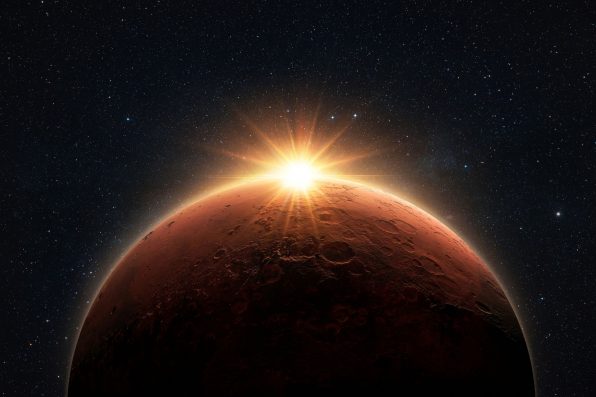While NASA’s Curiosity Rover Surveyed The Gale Crater On Mars, Researchers Discovered New Information About How The Red Planet Became Inhospitable To Terrestrial Life

Today, the surface of Mars is hostile and unfit for life to thrive. But in the past, it may have actually been suitable for life, especially since there is evidence that the planet’s surface was once covered with liquid water. NASA’s robotic explorers are combing Mars for clues of ancient life that might have lived there long ago.
Currently, the Curiosity rover is surveying the Gale Crater on Mars. Researchers used instruments on board the spacecraft to measure the isotopic composition of carbon-rich minerals in the crater.
They discovered new information about how the Red Planet’s climate transformed to result in an uninhabitable environment.
“The isotope values of these carbonates point toward extreme amounts of evaporation, suggesting that these carbonates likely formed in a climate that could only support transient liquid water,” said David Burtt, the lead author of the study from NASA’s Goddard Space Flight Center in Greenbelt, Maryland.
The samples they collected did not indicate that Mars’ ancient environment could have supported life on the surface of the planet.
However, it is possible that underground life or surface-level life could have existed before the carbonates formed.
Scientists like to study carbonates because they act as climate records. The minerals conserve the signatures of the environments in which they formed.
They can provide details about the temperature, acidity, and composition of the water and atmosphere.
There are two possible scenarios to explain the formation of the carbonates found in the Gale Crater.

alones – stock.adobe.com – illustrative purposes only
The first is that the carbonates materialized after a series of wet and dry cycles within the crater. In the second, the carbonates developed in salty water in cold, icy conditions at Gale.
“Wet-dry cycling would indicate alternation between more habitable and less habitable environments, while cryogenic temperatures in the mid-latitudes of Mars would indicate a less habitable environment where most water is locked up in ice and not available for chemistry or biology, and what is there is extremely salty and unpleasant for life,” said Jennifer Stern, a study co-author.
These climate scenarios have been proposed before, but this is the first time that isotopic evidence from rock samples has been used to support the scenarios.
The heavy isotope values in the Martian carbonates are much higher than the carbonate minerals on Earth. They also have the heaviest oxygen and carbon isotope values of any recorded materials on Mars.
According to the team, the wet and dry and the cold and salty climates are both needed to form such carbon- and oxygen-heavy carbonates.
The heavy isotope values were likely driven by an extreme degree of evaporation and then were preserved. Over time, the process rendered Mars uninhabitable.
The details of the study were published in the Proceedings of the National Academy of Sciences.
Sign up for Chip Chick’s newsletter and get stories like this delivered to your inbox.
More About:News